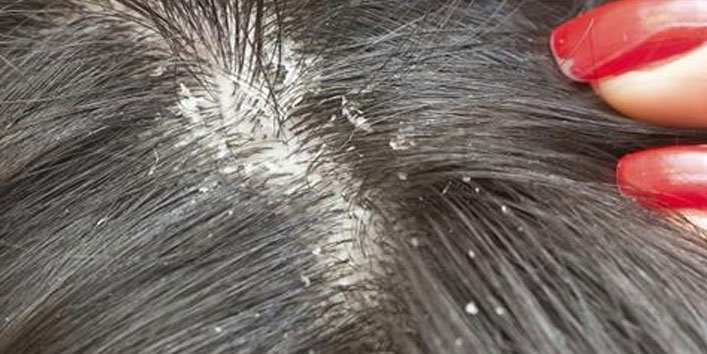Dandruff is one of the most common conditions which affects many people in the world. The condition could be embarrassing and can even affect your daily life, especially when it causes itching and when the flakes begin to appear on your clothes, making it impossible for you to put on dark coloured clothes.
There are several causes of dandruff, such as poor hygiene, dry skin, allergy, and medical conditions. And if you thought these symptoms are the same for all people affected by it, you are wrong. To face the problem, it is necessary to identify the types of dandruff. There are four most common types of dandruff which you need to know.
Types of dandruff
1. Dry skin dandruff

The most common kind of dandruff is dry skin dandruff which is found in those who have dry scalp. It is common during winter, but taking a bath with slightly hot water might be responsible for this condition as hot water could cause skin on the scalp to turn flaky. Dry skin-related dandruff is the common condition, which usually occurs in the winter. It is mainly caused due to having head bath with warm water making the scalp flaky and very dry. Individuals with dry and curly hair have this type of dandruff.
Treatment: Wash your hair with an anti-dandruff conditioner and pamper your hair with regular oil massage to reduce the itchiness and stimulate blood circulation. This condition needs to be treated with moisturizing shampoos and you should avoid coloring, perming, and dyes. Regular oil massage helps in treating itchiness and stimulating nutrition, blood circulation to the scalp.
Also Read 6 Haircare Myths That One Needs To Bust ASAP!
2. Oil-related dandruff

Accumulation of oil, sebum, and trapped dirt could lead to dandruff. The clump of dead skin cell attracts dirt and also forms itchy flakes on scalp. Excessive sebum production can be due to stress and more anxiety levels. Oil-related dandruff occurs due to an accumulation of sebum oil on scalp. Secreted by scalp glands, the oil can leads to formation of clumps and dead skin cells and dirt causing itchy flakes. Anxiety and stress level causes high amount of sebum oil production leading to this condition.
However, overproduction of the sebum could occur due to puberty, stress, pregnancy, and irregular shampooing, which can cause these problems. When excess sebum mixes with dead skin cells and dirt, it forms dandruff
Treatment: Try various methods to manage your anxiety and stress or seek the help of a doctor.
3. Fungal dandruff

Do you know fungal Malassezia is a natural condition on the scalp? But it begins to grow and thrive on the oily scalp. This kind of dandruff can appear in clumps and can be very difficult to get rid of by using anti-dandruff products. Fungal Malassezia is an excellent natural component that occurs on skin and the scalp. This fungus grows better on excessive oil on scalp and produces the oleic acid as a byproduct which produces skin cells to clump causing the white flakes.
It is highly contagious and could spread when people share their combs, hats, or towels, with someone with this condition. It produces oleic acid which increases the turnover of the skin cells. This leads to the formation of dandruff.
Talk to your doctor for good anti-fungal shampoos as well as medications to get rid of the condition.
Treatment: Talk to the dermatologist to get right treatment and medication.
Also Read: Top 9 Amazing Rules For Healthy And Beautiful Hair
4. Disease-related dandruff

The fourth kind of dandruff is disease-related and is associated with skin conditions like eczema and psoriasis. The overproduction of the skin cells in both these skin issues causes scaly skin on scalp. When it comes in contact with oil and dirt, it leads to the dandruff. Few skin conditions such as eczema and psoriasis stimulate excess production of the skin cells leading to scaly skin on scalp. When the skin cells come in contact with dirt and sebum oil, it leads to dandruff.
The other condition seborrheic dermatitis is more serious condition as it causes more redness, itchy scalp and sores. It is shown on the back of the neck and head. Consult a dermatologist before it spreads to ears and face for proper medication.
Treatment: Consult a doctor to prevent the spread of this skin condition.
Also Read: Here’s Why Washing Hair at Night Can Be Really Damaging!
Natural methods to get rid of dandruff
- Fenugreek seeds: Soak 2 spoons of fenugreek seed overnight and grind into a paste. Apply the paste over your scalp and then leave it on for about 30 minutes. Then wash it off with soapnut and water.
- Olive oil:Massage scalp with olive oil for about 10 minutes and leave it overnight. Wash it with shampoo and water the other morning too.
- Apple cider vinegar: Mix two small cups of the apple cider vinegar in two bowls of freshwater and pour it over scalp after applying shampoo. Massage it in a few minutes before washing it with fresh water.
- Baking soda: Mix three spoons of baking soda and three spoons of lemon juice into a small bowl of apple cider vinegar. Then apply the paste over the scalp and leave it for about 10 minutes. Wash it with water.
- Tea tree oil: Add coconut oil and few drops of tea tree oil and massage it onto the scalp and hair. You could leave it before washing it with an herbal shampoo.
